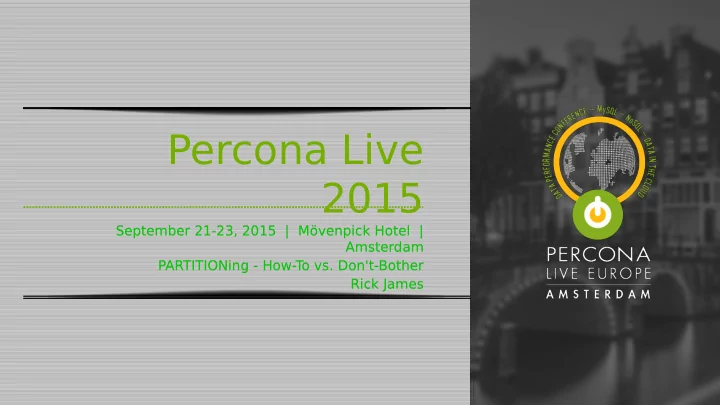

Percona Live 2015 September 21-23, 2015 | Mövenpick Hotel | September 21-23, 2015 | Mövenpick Hotel | Amsterdam Amsterdam PARTITIONing - How-T o vs. Don't-Bother PARTITIONing - How-T o vs. Don't-Bother Rick James Rick James
Agenda ● Quick overview of Partitioning ● Use cases (4) ● Details ● Postlog
Introduction What is Partitioning What is Partitioning
What is PARTITIONing? ● Bunch of sub-tables, each with subset of data ● “Pruning” picks which partition(s) to use – SELECT … WHERE ... ● Added in 5.1 (2005)
Partition T ypes PARTITION BY RANGE(col) ( PARTITION p000 VALUES LESS THAN (123), PARTITION p123 VALUES LESS THAN (246), PARTITION rest VALUES LESS THAN MAXVALUE ) Also PARTITION BY (though not useful) – KEY, LINEAR KEY, LIST, LIST COLUMNS, HASH, RANGE COLUMNS – SUBPARTITION BY ...
Specific Disk Layout ● DATA/INDEX DIRECTORY = ... – Better to stripe the drives (RAID-5/10) ● PARTITIONing is not the same as Sharding
RANGE Key ● Limitations – INTs, not FLOAT/DECIMAL – DATE/DATETIME/TIMESTAMP – TO_DAYS() and a few other functions – BY RANGE COLUMNS allows VARCHAR – (not much else allowed)
No Intrinsic Benefit ● Partitioning rarely provides any benefit – Never space savings – Rarely speed improvement ● I present 4 cases where partitioning can speed up some aspect
Use Cases Where PARTITIONing can shine Where PARTITIONing can shine
Use Case 1: Sliding Time ● Situation – News Articles; need to purge after 30 days Problem: ● – DELETE is slow Solution ● – CREATE TABLE … PARTITION BY RANGE(TO_DAYS(dt)) – DROP PARTITION – much faster than DELETE – Nightly script to DROP & REORGANIZE
Use Case 2: 2D index needed ● Situation – 2 ranges in WHERE WHERE lat BETWEEN 52.3 AND 52.5 AND lng BETWEEN 4.6 AND 5.1 Problem: ● – INDEXing can handle only one range Solution... ●
Use Case 2: 2D index needed (solution) ● Solution – Use lat*10000, lng*10000 (Scale to MEDIUMINT) PARTITION BY RANGE(lat) WHERE lat BETWEEN 523000 AND 525000 AND lng BETWEEN 46000 AND 51000 – PRIMARY KEY(lng, ...) – After getting items from 'square', filter by distance
Use Case 3: Last Partition's Index is hot ● Situation – Most activity is in “latest” partition, and – Table is too big to cache, but – One partition can be cached Problem ● – Some keys (esp. GUID) are I/O bound – Some queries (esp. scans) are I/O bound Solution... ●
Use Case 3: hot Partition (solution) ● Solution – Include Partition key in WHERE (to get pruning) – Only last partition is cached
Use Case 4: Export/Import by Partition ● Situation – You want to “archive” old data Problem: ● – No good way to carve out a chunk of a table – DELETE and OPTIMIZE are slow Solution ● – Partition such that you archive exactly 1 partition at a time – “Transportable Tablespaces” – (5.7 has cleaner code; possible in 5.6)
Further Details Miscellany notes Miscellany notes
Limitations Abs Limit Practical Limit Rows: >= 0 >= 1M Partitions: 1 - 8192 5 - 50 ● No diffs between Galera/MariaDB/PXC/Oracle ● No parallel actions → no benefit from multiple CPUs http://dev.mysql.com/doc/refman/5.6/en/partitioning-limitations.html ●
Index Limitations ● No FOREIGN KEY support ● UNIQUE & PRIMARY keys must include Partition key – Suggest tacking onto end – Hence, UNIQUE is rarely useful
Point Query not Faster ● SELECT * FROM t WHERE id = 12345; ● Given a billion rows: – Plain table: 5-level Btree – Partitioned: Pick partition, then 4-level Btree ● Not much difference
AUTO_INCREMENT PRIMARY KEY(id, partition_key) – versus PRIMARY KEY(cols, partition_key, id) INDEX(id) ● index(id) is sufficient for auto_inc ● PK starting with other cols gives clustering advantage ● Rarely useful to partition on PK.
Partition Pruning ● Most useful when WHERE clause restricts the Partition key ● Pruning may involve unnecessarily opening all partitions ● Pruning not done on writes (fixed in later versions) ● New in 5.6 (but rarely useful): – SELECT * FROM ... PARTITION (p0, p2) WHERE ...
EXPLAIN ● EXPLAIN PARTITIONS SELECT ... – (to see if pruning worked) ● BY RANGE(datetime) – 'first' partition contains 'bad' dates; always checked
Subtle issues ● ALTER TABLE … REORGANIZE, not OPTIMIZE PARTITION ● SHOW TABLE STATUS … – Data_free: – innodb_file_per_table = OFF: free space in ibdata1 – innodb_file_per_table = ON: usually 4-7M (in larger tables/partitions)
Postlog Futures, References Futures, References
Summary ● Only BY RANGE is useful ● Only 4 use cases provide performance benefit
Futures ● “Global Index” / UNIQUE / FOREIGN KEY – someday ● “Native partitioning” now in 5.7 – Decreases 'handler' overhead – Single file? ● Impact on 'transportable' partitions??
References http://dev.mysql.com/doc/refman/5.6/en/partitioning.html -- ref manual ● ● http://mysql.rjweb.org/doc.php/partitionmaint -- Use case 1 ● http://mysql.rjweb.org/doc.php/latlng -- Use case 2 ● http://forums.mysql.com/list.php?106 -- questions mysql@rjweb.org -- Rick James ●
Recommend
More recommend